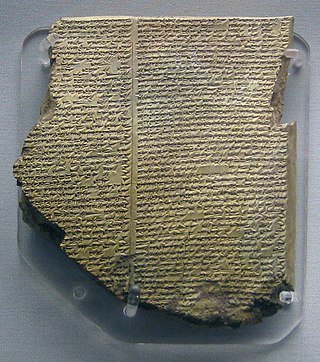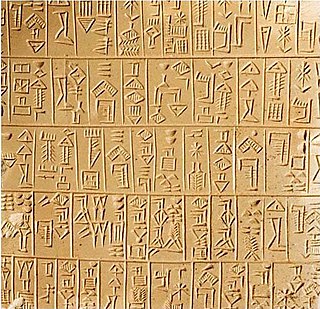Related Research Articles

Enlil, later known as Elil and Ellil, is an ancient Mesopotamian god associated with wind, air, earth, and storms. He is first attested as the chief deity of the Sumerian pantheon, but he was later worshipped by the Akkadians, Babylonians, Assyrians, and Hurrians. Enlil's primary center of worship was the Ekur temple in the city of Nippur, which was believed to have been built by Enlil himself and was regarded as the "mooring-rope" of heaven and earth. He is also sometimes referred to in Sumerian texts as Nunamnir. According to one Sumerian hymn, Enlil himself was so holy that not even the other gods could look upon him. Enlil rose to prominence during the twenty-fourth century BC with the rise of Nippur. His cult fell into decline after Nippur was sacked by the Elamites in 1230 BC and he was eventually supplanted as the chief god of the Mesopotamian pantheon by the Babylonian national god Marduk.

Gilgamesh was a hero in ancient Mesopotamian mythology and the protagonist of the Epic of Gilgamesh, an epic poem written in Akkadian during the late 2nd millennium BC. He was possibly a historical king of the Sumerian city-state of Uruk, who was posthumously deified. His rule probably would have taken place sometime in the beginning of the Early Dynastic Period, c. 2900 – 2350 BC, though he became a major figure in Sumerian legend during the Third Dynasty of Ur.

Inanna is the ancient Mesopotamian goddess of love, war, and fertility. She is also associated with sensuality, procreation, divine law, and political power. Originally worshipped in Sumer, she was known by the Akkadian Empire, Babylonians, and Assyrians as Ishtar. Her primary title is "the Queen of Heaven".

The Epic of Gilgamesh is an epic from ancient Mesopotamia. The literary history of Gilgamesh begins with five Sumerian poems about Gilgamesh, king of Uruk, some of which may date back to the Third Dynasty of Ur. These independent stories were later used as source material for a combined epic in Akkadian. The first surviving version of this combined epic, known as the "Old Babylonian" version, dates back to the 18th century BC and is titled after its incipit, Shūtur eli sharrī. Only a few tablets of it have survived. The later Standard Babylonian version compiled by Sîn-lēqi-unninni dates to somewhere between the 13th to the 10th centuries BC and bears the incipit Sha naqba īmuru. Approximately two-thirds of this longer, twelve-tablet version have been recovered. Some of the best copies were discovered in the library ruins of the 7th-century BC Assyrian king Ashurbanipal.

Ziusudra of Shuruppak is listed in the WB-62 Sumerian King List recension as the last king of Sumer prior to the Great Flood. He is subsequently recorded as the hero of the Eridu Genesis and appears in the writings of Berossus as Xisuthros.

In Mesopotamian mythology, Ereshkigal was the goddess of Kur, the land of the dead or underworld in Sumerian mythology. In later myths, she was said to rule Irkalla alongside her husband Nergal. Sometimes her name is given as Irkalla, similar to the way the name Hades was used in Greek mythology for both the underworld and its ruler, and sometimes it is given as Ninkigal, lit. "Lady of the Great Earth".

Enkidu (Sumerian: 𒂗𒆠𒄭EN.KI.DU10) was a legendary figure in ancient Mesopotamian mythology, wartime comrade and friend of Gilgamesh, king of Uruk. Their exploits were composed in Sumerian poems and in the Akkadian Epic of Gilgamesh, written during the 2nd millennium BC. He is the oldest literary representation of the wild man, a recurrent motif in artistic representations in Mesopotamia and in Ancient Near East literature. The apparition of Enkidu as a primitive man seems to be a potential parallel of the Old Babylonian version (1300–1000 BC), in which he was depicted as a servant-warrior in the Sumerian poems.

Ninsun was a Mesopotamian goddess. She is best known as the mother of the hero Gilgamesh and wife of deified legendary king Lugalbanda, and appears in this role in most versions of the Epic of Gilgamesh. She was associated with Uruk, where she lives in this composition, but she was also worshiped in other cities of ancient Mesopotamia, such as Nippur and Ur, and her main cult center was the settlement KI.KALki.
Bitu or Bidu was a minor Mesopotamian god who served as the doorkeeper of the underworld. His name is Akkadian in origin, but he is present in Sumerian sources as well.

Sumerian literature constitutes the earliest known corpus of recorded literature, including the religious writings and other traditional stories maintained by the Sumerian civilization and largely preserved by the later Akkadian and Babylonian empires. These records were written in the Sumerian language in the 3rd and 2nd millennia BC during the Middle Bronze Age.

Dumuzid or Dumuzi or Tammuz, known to the Sumerians as Dumuzid the Shepherd and to the Canaanites as Adon, is an ancient Mesopotamian and Levantine deity associated with agriculture and shepherds, who was also the first and primary consort of the goddess Inanna. In Sumerian mythology, Dumuzid's sister was Geshtinanna, the goddess of agriculture, fertility, and dream interpretation. In the Sumerian King List, Dumuzid is listed as an antediluvian king of the city of Bad-tibira and also an early king of the city of Uruk.
There are many references to ghosts in ancient Mesopotamian religion – the religions of Sumer, Babylon, Assyria and other early states in Mesopotamia. Traces of these beliefs survive in the later Abrahamic religions that came to dominate the region.
A lilu or lilû is a masculine Akkadian word for a spirit or demon.

Lugalbanda in the Mountain Cave is a Sumerian mythological account. It is one of the four known stories that belong to the same cycle describing conflicts between Enmerkar, king of Unug (Uruk), and an unnamed king of Aratta. The story is followed by another known as Lugalbanda and the Anzu Bird, together forming the two parts of one story. The stories, from the composer’s point of view, take place in the distant past. The accounts are believed to be composed during the Ur III Period, although almost all extant copies come from Isin-Larsa period. Tablets containing these stories were found in various locations of southern Iraq, primarily in the city of Nippur, and were part of the curriculum of Sumerian scribal schools during the Old Babylonian period.

The Sumerian disputation poem or Sumerian debate is a genre of Sumerian literature in the form of a disputation. Extant compositions from this genre date to the middle-to-late 3rd millennium BC. There are six primary poems belonging to this genre. The genre of Sumerian disputations also differs from Aesopic disputations as the former contain only dialogue without narration. In their own language, the texts are described as adamin in the doxologies at the end of the poem, which literally means "contests (between) two".
Gilgamesh, Enkidu, and the Netherworld is one of five extant compositions of the Sumerian language about the deeds of the hero Gilgamesh. It was known to the ancients by its incipit, ud ri-a ud sud-rá ri-a or "In those days, in those faraway days". It spans 330 lines.
Sisig is the dream god in Sumerian religion and the son of the sun god Utu. He is named in the Iškar Zaqīqu, an eleven tablet compendium of oneiromancy written in Akkadian.

Gilgamesh and Aga, sometimes referred to as incipit The envoys of Aga, is an Old Babylonian poem written in Sumerian. The only one of the five poems of Gilgamesh that has no mythological aspects, it has been the subject of discussion since its publication in 1935 and later translation in 1949.
Tale of Gudam, also known as the Gudam Epic or Inanna and Gudam, is a Mesopotamian myth known from two Old Babylonian copies from Nippur. It tells the tale of Gudam, an otherwise unknown character, who goes on a rampage in Uruk. The minstrel Lugalgabagal criticizes his behavior, but his remarks only enrage him more. He is finally stopped by a fisherman of Inanna. The goddess herself subsequently decides to spare his life when he starts pleading, and sends him to live in a ditch near Zabalam. Many aspects of the story are a subject of debate in Assyriology, including the nature of Gudam and the identity of the fisherman. Possible connections between the Tale of Gudam and other texts have also been noted. In particular, Gilgamesh and the Bull of Heaven is considered a close parallel, with some authors outright considering the two texts to be variants of one narrative.
Ardat-lilî was a Mesopotamian demon. She is described as the ghost of a young woman who died without experiencing sexual fulfillment or getting married, and as a result attempts to seduce young men. She is one of the members of the category of lil demons, who were considered subjects of Pazuzu. A text placing her in the entourage of the god Erra is also known. Incantations directed against her are attested as early as in the Old Babylonian period. References to her are also known from other genres of texts.
References
Citations
- ↑ Kramer 1944.
- ↑ Kramer 1944, p. 4.
- ↑ Gadotti 2014, p. 1.
Sources
- Gadotti, Alhena (2014). Gilgamesh, Enkidu, and the Netherworld and the Sumerian Gilgamesh Cycle. De Gruyter.
- Kramer, Samuel Noah (1944). "The Death of Gilgamesh". Bulletin of the American Schools of Oriental Research. 94 (1): 2–12. doi:10.2307/1355151. JSTOR 1355151.